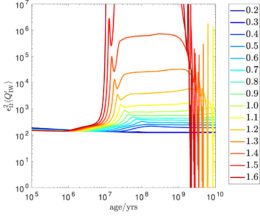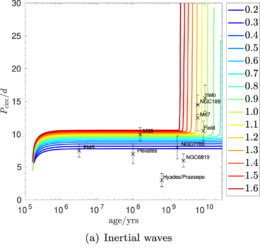How do binaries in circular orbits come to be, especially for pairs of solar-type stars? Using stellar models, a researcher has brought us closer to understanding how the loss of energy in a system eventually leads it to circularize.
Good Things Come in Pairs
When you look out into the night sky, you may just see a bunch of singular points of light, but it is estimated that up to 85% of all stars are in multi-star systems — binaries, triples, or even quadruple systems. Around ~50% of stars like our Sun are actually in pairs. Binaries have been observed in all different shapes and sizes, from very elliptical orbits where the orbital period is on the order of multiple years to very close circular binaries that have orbital periods of days. Circular orbits could be caused by a number of physical mechanisms that gradually reduce a binary’s eccentricity over time, but we still don’t fully understand which mechanisms are at work or how. Adrian Barker (University of Leeds) has looked at circular solar-type binary systems to try to help solve the mystery.

The age of a star plotted against the quality factor, an inverse measure of dissipation efficiency. This shows that inertial wave dissipation is very efficient during the pre-main-sequence phase when the star is young but becomes less efficient later on in the stars’ lifetime. The different colored lines represent the different star masses in solar masses. [Barker 2022]
Making Waves in the Field of Binary Evolution
One possible way that the orbits of binary stars could become circular over time is through tidal dissipation: the loss of energy in a binary system due to gravitational distortions of the member stars. Barker tested this theory by modeling solar-type and low-mass stars in binary systems with the Modules for Experiments in Stellar Astrophysics (MESA) stellar evolution code. For the modeled binary systems, Barker studied the convection zones of the stars and worked out the tidal dissipation due to inertial waves — oscillations that take place within the star — in the systems. He also explored relations such as how stellar radius evolves with age and how the circularization period (the maximum orbital period in which binary orbits are perfectly circular) evolves with time.

Age of the system plotted against the maximum binary period that circularizes, showing how energy dissipation from the inertial waves is capable of circularizing orbits out to 10-day periods before a few million years. The different colored lines represent the different star masses. [Barker 2022]
Coming Full Circle
Previous theoretical work on this subject found that inertial wave dissipation in binary systems could help circularize binary orbits, but it didn’t seem strong enough to account for full circularization of solar-type main-sequence star binaries. While other studies searched for other mechanisms to explain it, this study concludes that tidal dissipation due to inertial waves is sufficient to explain the circularization of binary orbits and the synchronization of the spins of the stars. Barker also found that the maximum period that circularizes due to this mechanism increases with binary age, consistent with what observations of main-sequence binary systems have shown.
While this study focused on a highly simplified model and involved proof-of-concept calculations, the author hopes that other studies will look at tidal dissipation in more detail with more sophisticated calculations while also focusing on the dynamical evolution of stellar populations.
Citation
“Tidal Dissipation Due to Inertial Waves Can Explain the Circularization Periods of Solar-type Binaries,” Adrian J. Barker 2022 ApJL 927 L36. doi:10.3847/2041-8213/ac5b63
